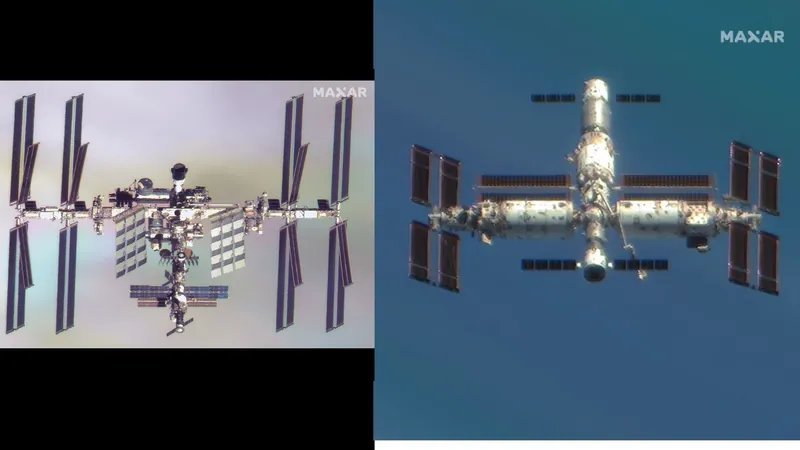
Unearthing the Mystery: The Enigmatic Haruj Volcanic Field in Libya's Sahara Desert
2025-01-21
Author: Daniel
Introduction
A mesmerizing and surreal landscape lies beneath the vast sands of the Sahara Desert—a colossal expanse of ancient, charcoal-black lava that has formed what looks like a ghostly, gold-speckled shadow when viewed from space. Known as the Haruj volcanic field, this incredible geological formation spans approximately 17,000 square miles (44,000 square kilometers) in central Libya, making it one of the most significant volcanic sites on the African continent.
Geological Composition
According to the U.S. Geological Survey, the Haruj volcanic field comprises around 150 extinct volcanoes that vary in size from diminutive vents to imposing shield volcanoes. Some of the lava rock in this region dates back to an astonishing 6 million years, while other eruptions occurred as recently as a few thousand years ago, as reported by the Smithsonian's Global Volcanism Program.
Landscape Characteristics
Despite its seemingly smooth and flat appearance from above, the Haruj field is anything but uniform. The terrain is riddled with rugged areas where successive volcanic activity has caused various layers of rock to accumulate, creating a landscape filled with irregular formations. Notably, there are over 30 volcanic cones that tower above the surrounding terrain, with their heights reaching over 330 feet (100 meters). The highest peak in the entire field soars to approximately 3,900 feet (1,200 meters) above sea level, making it a striking feature of the Libyan Sahara.
Satellite Imagery
The captivating satellite images showcasing this volcanic expanse are a product of advanced technology known as a "best pixel mosaic." This technique harnesses the power of algorithms to sift through numerous images, pixel by pixel, to craft a coherent image clear of obscuring elements like clouds and dust storms, as detailed by NASA's Earth Observatory. This meticulous process also highlights sandy patches nestled between the lava formations, revealing golden flecks across the dark surface, adding an enchanting touch to the massive lava field.
Volcanic Activity and Formation
Interestingly, the formation of the Haruj volcanic field diverges from typical volcanic activity, which is often associated with tectonic plate boundaries. Instead, these massive outpourings of lava were most likely caused by hot mantle plumes that pushed magma up directly from Earth’s interior, forming a reservoir beneath the surface. Consequently, eruptions in the Haruj region were primarily effusive, resembling the slow, steady lava flows seen in Hawaii's iconic Kilauea volcano rather than explosive ejections.
Distinct Sections
Research suggests that the Haruj volcanic field may comprise two distinct sections: Al Haruj al Aswad in the north, showcasing older lava, and Al Haruj al Abyad in the south, which is of more recent origin. However, the lack of clear demarcation makes it challenging to identify where one field ends and another begins, leading most scientists to regard it as a unified geological phenomenon.
Conclusion
As scientists continue to unravel the enigma of the Haruj volcanic field, this extraordinary landscape remains a treasure trove of geological wonders, hiding secrets of Earth’s volcanic past beneath its golden-speckled façade. What more could this hidden gem reveal? Stay tuned as researchers delve deeper into the mysteries shrouded in the Sahara's ancient lava flows!






 Brasil (PT)
Brasil (PT)
 Canada (EN)
Canada (EN)
 Chile (ES)
Chile (ES)
 Česko (CS)
Česko (CS)
 대한민국 (KO)
대한민국 (KO)
 España (ES)
España (ES)
 France (FR)
France (FR)
 Hong Kong (EN)
Hong Kong (EN)
 Italia (IT)
Italia (IT)
 日本 (JA)
日本 (JA)
 Magyarország (HU)
Magyarország (HU)
 Norge (NO)
Norge (NO)
 Polska (PL)
Polska (PL)
 Schweiz (DE)
Schweiz (DE)
 Singapore (EN)
Singapore (EN)
 Sverige (SV)
Sverige (SV)
 Suomi (FI)
Suomi (FI)
 Türkiye (TR)
Türkiye (TR)
 الإمارات العربية المتحدة (AR)
الإمارات العربية المتحدة (AR)